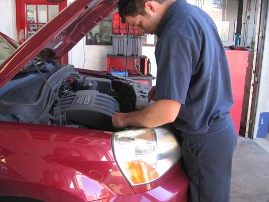Some parts of your vehicle are easy for you to see and there isn’t any problem deciding if they need replacing. You can glance at your washer fluid tank and tell if its low and needs to be refilled, it isn’t difficult to tell if your headlight isn’t working or if the tread on your tires is wearing down and you need new tires. But there are some parts on a vehicle that are more difficult to see and need to be maintained on a regular basis so that they don’t break or stop working unexpectedly.
Replacing your timing belt is one of these parts. Your timing belt usually gives you no indication of wear or that it is about to fail- it simply snaps when you’re driving and leaves you stranded. This can be a major inconvenience and cost quite a bit of cash, if you have to have the car towed to an auto repair shop. So how can this be avoided? Regular maintenance checks.
The timing belt is a ribbed band of rubber, reinforced with strands of fiberglass, which controls the timing of your engine’s camshafts. The camshaft is the shaft that opens and closes the intake and exhaust valves. These valves let in the air that creates the combustion and also vents the exhaust that is created by the combustion. The timing belt connects the crankshaft with the camshaft and is the only part that keeps them in sync with one another. If the timing belt breaks, the car has no other option than to shut down. Replacing your timing belt at the proper time can save yourself a lot of problems. Most vehicles recommend replacing the timing belt between 60,000 to 75,000 miles, but it’s a good idea to check the recommendations made specifically for your car by its manufacturer.
If you discover it’s about time you replaced your timing belt, click here for a special coupon and come in and see us.

Leave a Reply
You must be logged in to post a comment.